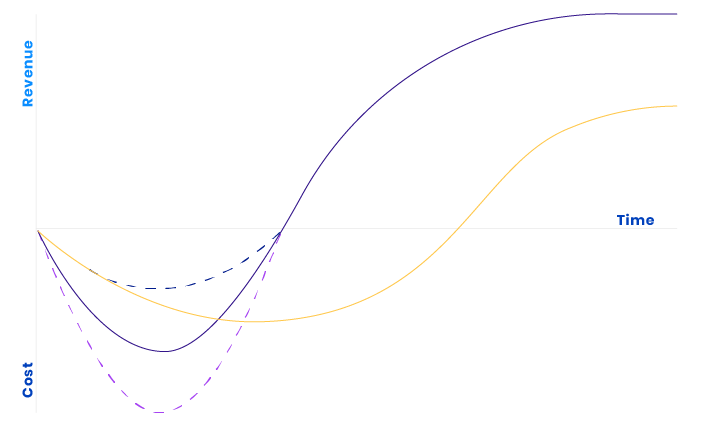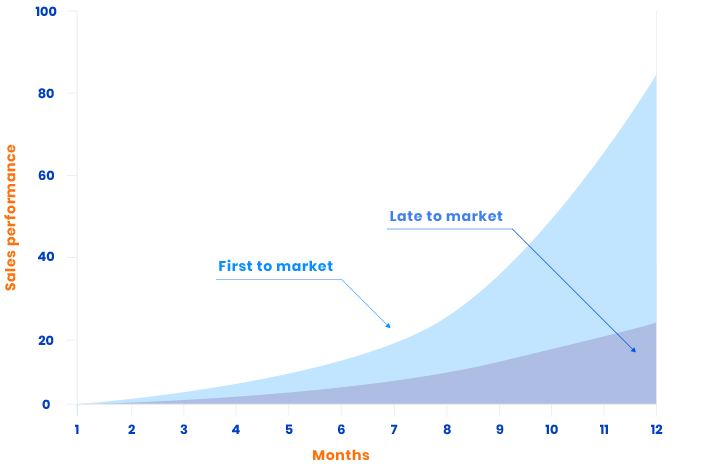-
Product Management
Software Testing
Technology Consulting
-
Multi-Vendor Marketplace
Online StoreCreate an online store with unique design and features at minimal cost using our MarketAge solutionCustom MarketplaceGet a unique, scalable, and cost-effective online marketplace with minimum time to marketTelemedicine SoftwareGet a cost-efficient, HIPAA-compliant telemedicine solution tailored to your facility's requirementsChat AppGet a customizable chat solution to connect users across multiple apps and platformsCustom Booking SystemImprove your business operations and expand to new markets with our appointment booking solutionVideo ConferencingAdjust our video conferencing solution for your business needsFor EnterpriseScale, automate, and improve business processes in your enterprise with our custom software solutionsFor StartupsTurn your startup ideas into viable, value-driven, and commercially successful software solutions -
-
- Case Studies
- Blog
How to Reduce Time to Market for Digital Products
Veni, vidi, vici! Julius Caesar allegedly said after his victory in the battle of Zela. While this catchphrase definitely has a militarist meaning (“I came; I saw; I conquered!”), it ideally describes the product market penetration: Come first, see consumers' needs, and conquer the niche.
In this article, you’ll discover the time to market (TTM) metric from the perspective of how to minimize it. We’ll start with defining TTM, continue with classifying the types of time to market, then show the importance of TTM, and finally detail how to reduce it.
What is time to market (TTM)?
There are many definitions of time to market (see Wikipedia and Techopedia for starters), but all of them have some commonalities. We’ve formed our own definition that is the simplest possible:
For digital products, time to market is the period from the very beginning of product development to a product’s being available to users. In other words, it’s the time from idea to first release.
Types of time to market
The length of the time to market is highly dependent on the approach used to measure it. There are plenty of examples where TTM was reduced simply by excluding important stages from the calculation.
When measuring your TTM and evaluating possibilities for its reduction, pay close attention to your business goals. There are different types of time to market exist. All of them are aimed at achieving different goals. Below you can find the most common time to market reducing approaches (or types of time to market):
- Fastest possible release. This type of TTM is applicable in fast-changing markets and rather popular in IT startups. It is commonly used when building an MVP.
- Strictly within a schedule. This approach is about keeping the time variable of the project triangle constant. Sticking strictly to a schedule works, for example, when development is outsourced and the fixed release date is an integral part of the agreement between client and contractor.
- Agility priority. The most change-friendly type of TTM is also the most universal. Many acceleration techniques allow you to apply changes keeping launch dates safe.
- Productivity priority. This type of TTM isn’t actually about reducing the time to market. But sometimes performance may be the top priority. This type of TTM is often used by managers of outsourcing companies who aim to implement the maximum number of projects or features with the given team within a given period of time.
- Sales priority. It’s not about long-term planning, but this type of TTM is rather common. It’s applicable when a company is planning a release firstly to overcome weak financial results. For example, the release could coincide with an event during which sales will probably be high no matter the quality.
- Avoiding rework. This approach is common for the waterfall methodology and is still applicable in the military, government, and strictly regulated industries. This type of TTM is also popular where the cost of errors may be quite high, such as in the healthcare industry. The reverse side of the coin is higher costs and much lower overall performance.
- Detailed schedule. This approach is based on following a project schedule. For example, the initial release might need to take place on 1 March, with the next strictly scheduled for 15 April followed by another on 5 May, and so on.
How time to market is tied with cost and revenue
To better understand how time to market is correlated to cost and revenue, let’s look at a graph:

Some findings based on the graph:
- The cost of development within a shorter TTM can be both lower and higher than within a longer TTM.
- A shorter TTM is a way to enter the market first and occupy the leading position.
- A shorter TTM also leads to higher revenue and profits.
The importance of reducing time to market for your product
The importance of reducing TTM is obvious. As we said before, the earlier you enter the market, the better your position will be. But let’s face some numbers.
- Classic McKinsey research published in the January‒February 1991 issue of Harvard Business Review shows that six extra months of time to market caused losses of 33 percent of after-tax profits. Given that this research was conducted in 1991, with modern digital products, an extra six months could easily be twice as harmful.
- Research by Green Hills Software found that the first comer occupies up to 70 percent of a newborn market niche, while the runner-up can expect nothing more than 20 percent.

How to reduce time to market: a cheat sheet by RubyGarage
We’ve prepared a cheat sheet that will help you reduce your TTM.
- Choose the types that are aimed at TTM reduction. “The fastest possible release” or “Agility priority” TTM types fit well, for example.
- Validate and test your product vision, ideas, and hypotheses at the earliest possible stages. This means undertaking a full range of measures including communicating with stakeholders, prototyping, and holding requirements sessions. When you’ve got an idea, you should discuss it with stakeholders, analyze its potential value, check its correlation with business needs, evaluate its implementability, etc. You can use the SMART technique for this.
- Prototype early and often. Adding this as a separate piece of advice shows its importance. Prototyping is a way for the stakeholders to be on the same page about both product vision and scope. And frequent prototyping sessions help to minimize any imbalance between stakeholders.
- Build an MVP. In the Lean startup cycle, it sounds like “build an MVP, measure, learn.” And remember: An MVP is not just a flawed release of your software or another digital product that works somehow. A real MVP must provide its own value to users.
- Reduce the number of simultaneous projects. This advice is for agencies and multi-product companies where one team is dedicated to several projects simultaneously. If you want to do one thing faster, free your workforce from other jobs.
- Prioritize more strictly both between and inside projects. The first part of this advice overlaps with the previous advice on reducing the number of simultaneous projects. The second part is about prioritizing features. Use proven tools for prioritization like the MoSCoW method or anything else that’s convenient for you.
- Stay value-focused. Each feature you implement must bring the product and its users value. The temptation to make something cool-looking but valueless is common enough that this practice has been named “gold plating.” And you should stay away from it.
- Actively involve users and stakeholders in your studies. Don’t think you alone know everything about user behavior. This misguided belief is a popular cause of startup failure (17 percent of failures can be attributed to a lack of user-friendliness and 14 percent to ignoring customers). The more people who are closely tied to the product or will use it you'll involve in your studies, the more likely your product will succeed.
- Follow standards for roles and responsibilities, workflows, and approaches. Any standardized workflow is far more efficient than moving by intuition. This is true for staff: We bet your team prefers transparent relationships and understandable responsibilities. Don’t try to reinvent the wheel where it’s absolutely unnecessary.
- Set up and keep infrastructure that’s relevant to your needs. This is about your server power, continuous integration and delivery, software tools, etc. Remember about possible load spikes and other risk factors related to infrastructure.
- Formalize your knowledge management. Some of the processes you employ are unique, of course. You should formalize these processes and operational flows to reach greater performance and reduce your time to market. We strongly recommend you do the same with all your knowledge management practices.
There are dozens of ways you might reduce your product’s TTM. Each may be efficient or inefficient in your particular case. The best option is to try implementing all applicable methods of reducing TTM one by one.
Reducing time to market is a part of product discovery
Did you know that the product discovery stage of product development includes all the main TTM reduction activities? Let’s delve deeper into the process to see why this is true and identify which product discovery activities reduce the time to market.
The product discovery steps are as follows:
- Product alignment. This step is about setting up communication with stakeholders and kicking off the product discovery stage and document flows. A properly set communication must involve the stakeholders in studies. Setting up the document flow can contain requirements of using particular standards for workflows and knowledge management.
- Research and elicitation. This step includes defining the product vision, creating the business model, and conducting market, target audience, and competitor research. As you can see, this is highly relevant to validating your product vision, ideas, and hypotheses as well as staying value-focused and making strict prioritization decisions.
- Ideation. At this step, our product management team identifies the product concept and designs the product’s feature set. This process is tied to building an MVP, prioritizing inside the project, and staying value-focused.
- Planning and estimation. This step includes estimating the previously defined feature set, creating a strategy for building an MVP, budgeting, and developing the schedule baseline. At this step, it’s time to choose the proper type of TTM. Some actions are aimed at better validation of features and ideas, while others are aimed at building an MVP, prototyping, and prioritizing the features.
As you can see, the product discovery process employed at RubyGarage is closely interwoven with reducing the time to market. This means our team does its best to cut your TTM during the product discovery stage, keeping budget and quality safe.
Conclusion
Here are key takeaways:
- In new markets, the first product usually takes all (or most) of the market share.
- The cost of TTM isn’t correlated with the length of time to market.
- Shorter TTM leads to higher revenues.
- There are various goal-based types of TTM.
- You can use many different instruments to reduce your TTM.
- The results of reducing TTM can vary widely.
- If you don’t have enough experience, it’s best to hire professionals.
We hope this article helps you avoid bad decisions and reduce your time to market enough to meet your goals!
FAQ
-
For digital products, time to market is the period from the very beginning of product development to a product’s being available to users. In other words, it’s the time from idea to first release.
-
- The shorter TTM, the more revenue your product will receive
- The TTM length doesn't directly correlate with development costs (a shorter TTM may be more expensive than the longer TTM, for example)
-
Reducing time to market is a wide range of activities aimed at similar goals. It's not a special service but it is a part of our product discovery stage of product development. Read more about our product development services for startups.










